4 Symptoms of a Cracked Oil Pan (and Repair Cost)
Are you noticing worrisome oil stains in your driveway or garage? While it may end up being a common leaking valve cover gasket, the possibility of an issue much more serious in nature does exist: a cracked oil pan!
Read on to learn the common symptoms of a cracked oil pan, whether you can continue driving, and how much it’s going to cost to repair (or replace) the oil pan.
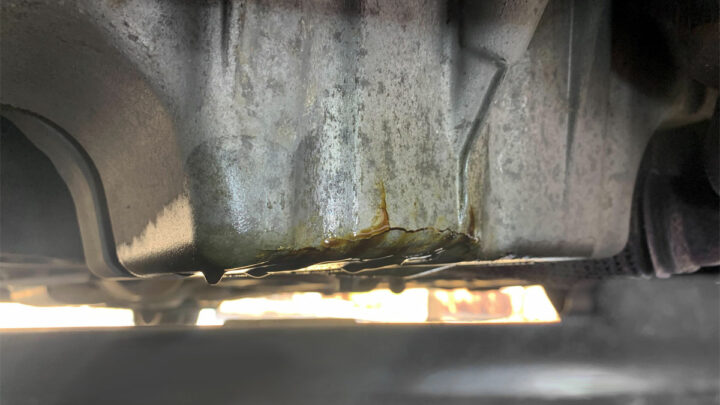
The Purpose of an Oil Pan
An oil pan is part of an internal combustion engine, found in automotive applications. This pan serves as a catchment basin or reservoir of sorts for the lubricating oil within an engine.
The exact size/volume of an oil pan often differs from one engine to the next, and is largely dependent upon an engine’s overall oil capacity. Generally speaking, larger engines (like an 8-cylinder) have more passageways and moving parts and require more oil for adequate lubrication and cooling than smaller (ie: 4-cylinder) engines.
When parked, not running, a significant portion of an engine’s lubricating oil rests within the oil pan. When running, this oil is circulated throughout a vehicle’s engine, beginning this cycle at the oil pan, via an internally-located oil pickup.
After being pumped throughout the engine, this oil gravity drains back to the oil pan from which it was originally pulled.
Read Also: 6 Signs of an Oil Pan Gasket Leak
Cracked Oil Pan Symptoms
There are several symptoms commonly associated with an oil pan leak. Luckily, most are relatively easy to recognize.
#1 – Oil In Driveway/Garage

One of the most obvious symptoms of a cracked oil pan is noticeable oil stains in your driveway or garage. While these leaks are not always coming from the oil pan itself, a thorough inspection of this assembly is a fine place to start.
#2 – Frequently Low Oil Levels
Does it seem like you’re having to constantly top of your vehicle’s oil? If so, then you might be dealing with a cracked oil pan.
Though a thorough inspection of your vehicle’s engine will be required to achieve a sound diagnosis, a crack in an engine’s oil pan can lead to oil loss at an alarming rate.
#3 – Abnormal Engine Noises
Rapid oil loss can result when an oil pan’s integrity is compromised. Unfortunately, if this oil loss is not noted quickly enough, a lack of oil pressure can result. In turn, you might notice abnormal engine noises, or key in on the fact that your engine sounds louder than normal.
#4 – Illuminated Oil Pressure Light

If enough oil escapes from a defined crack in an engine’s oil pan, a risk of oil pressure loss is presented. As a result, you may notice the illumination of a low engine oil light or oil pressure light on your vehicle’s dash.
Causes of a Cracked Oil Pan
There are two primary causes associated with the cracking of an engine’s oil pan. The first, and most prevalent revolves around impact-related damage.
Simply put, many oil pans are damaged simply by driving over something that should not have been traversed (like a curb or large rock), navigating uneven surfaces (speedbumps) at too high of speed, or taking a vehicle with insufficient ground clearance off-road.
Even a Jeep doesn’t give you unlimited ground clearance, and even more importantly, your sedan isn’t a Jeep!
Another potential, yet much rarer cause of oil pan damage is the flash cooling of a pan’s exterior when operating at extreme temperatures.
This tends to occur most commonly when an overheated engine is splashed with water, as a vehicle drives through ponding rainwater. This is yet another reason why you should never drive a vehicle with an engine that is overheating.
Related: How to Remove a Stripped Oil Drain Plug
When It’s Not a Crack
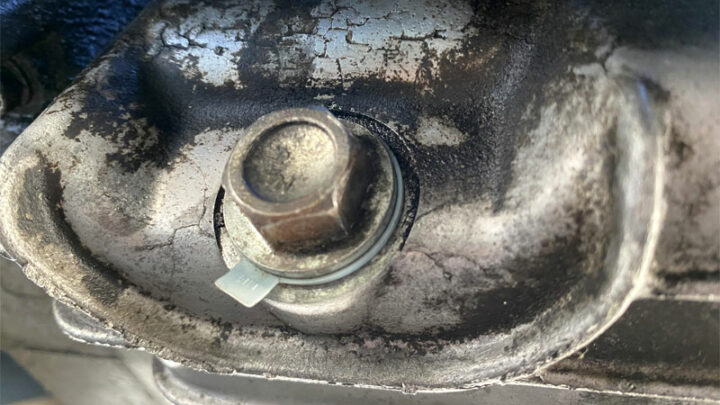
Casting flash and minor surface tears/cracks are both fairly common (and generally harmless) manufacturing imperfections that can easily be misdiagnosed as a cracked oil pan. These imperfections form during the casting process when molten material escapes through the seams of a mold or small, branch-like cracks appear during the cooling process as natural shrinkage of the metal occurs.
Both of these are typically only superficial imperfections that do not affect the structural integrity of the oil pan. However, a thorough cleaning and inspection is necessary to confirm whether you’re dealing with a minor casting defect or a legit oil pan crack.
Repair vs Replacement
When an engine’s oil pan cracks, you have two paths of resolution to choose from. You can simply attempt to fix the crack, to avoid further oil loss, or you can replace the damaged pan entirely. The following are the pros and cons of each option.
Repair
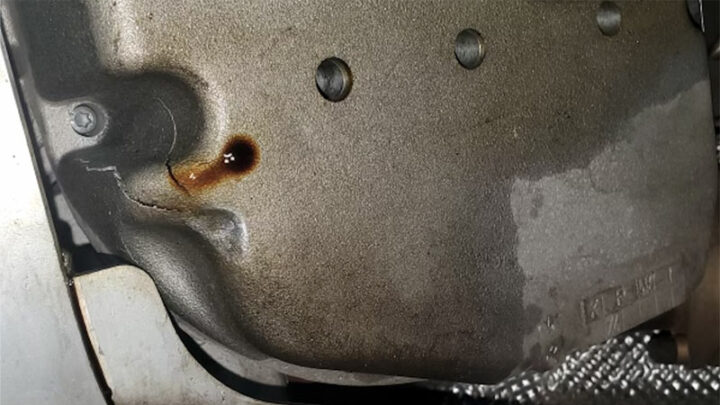
Repairing a cracked oil pan generally involves the use of a bonding agent or chemical cement, such as JB Weld. While this does work in many applications, at least in the short-term, longevity is no guarantee.
However, a repair of this nature can often be completed for less than $30, making it a great option for vehicles that are not intended for long-term use, or pans with hairline cracks.
Additionally, you can spring for the additional cost of having your oil pan welded, though this often costs nearly as much as replacing the oil pan entirely.
Replacement
Without any doubt, the replacement of a damaged oil pan is the best route forward. This replacement ensures that the oil leak in question does not persist.
That said, this can also be quite costly, with many replacement oil pans costing in excess of $150-$200. This doesn’t even count labor, which can easily tally upwards of $350-$500. Nonetheless, this expenditure can serve as a wise investment, if you intend to keep your vehicle for the long haul.
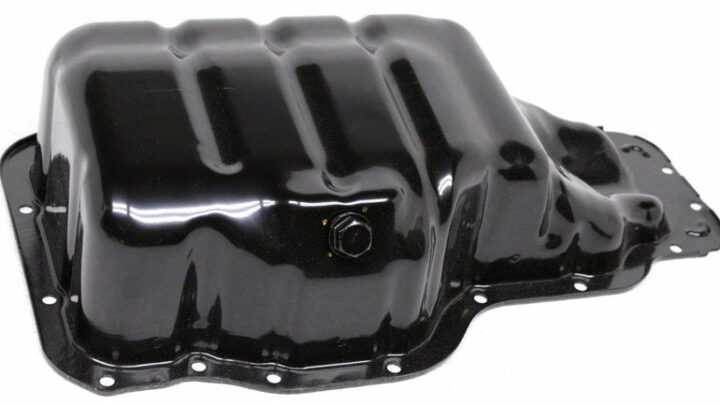
Is It Safe to Continue Driving?
The matter of whether or not it is safe to drive with a cracked oil pan is largely dependent on the significance of the crack itself. While some cracks can be very minor, allowing little more than minor oil seepage over a prolonged period of time, others, if severe enough, can drain an engine of it’s in extremely short order.
If a leak is extremely minor, you can likely get away with driving your vehicle for a short period of time, as long as you closely monitor your engine oil level.
On the contrary, a vehicle should never be driven with a severely cracked oil pan, as this can lead to rapid oil loss, and catastrophic engine failure, should the engine in question continue in operation.
In any event, you should plan on replacing or repairing a cracked oil pan as soon as possible. This will prevent you from incurring additional damage to your engine, should a substantial amount of oil be lost. If you don’t feel comfortable tackling such repairs yourself (most won’t be), an appointment should be made with a trusted automotive service center as soon as possible.
Can JB Weld Be Used as a Temporary Fix?
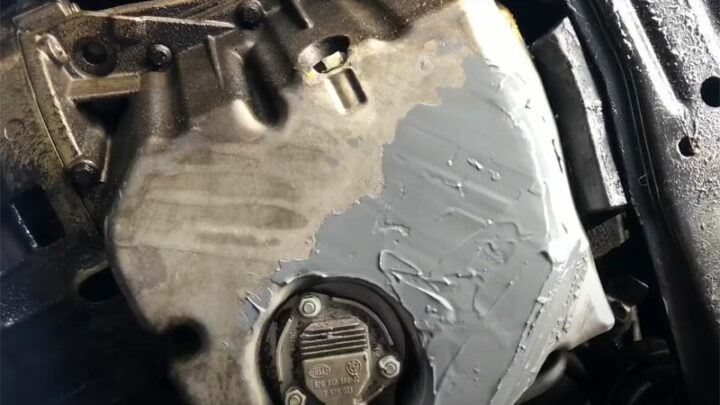
Believe it or not, JB Weld can actually be used in some cases to temporarily patch a cracked oil pan. While the application of this product should not be thought of as a proper fix, many have reported achieving satisfactory results with its use, at least in the short term.
However, as with anything, preparation is key when attempting to patch up a cracked oil pan with JB Weld.
- Before attempting to repair a cracked oil pan with JB Weld, all oil should be drained from the pan in question.
- Next, the area of the pan that is to be patched should be thoroughly cleaned and lightly sanded.
- Finally, the JB Weld to be used should be mixed as directed and applied in a smooth, even fashion.
Preventing Oil Pan Damage
The single biggest cause of oil pan damage is an inadvertent strike with a solid object. This often occurs when one accidentally runs off the road, traverses a speed bump too quickly, or hops a curb.
In any such case, the opportunity for oil pan contact presents itself. Therefore, damage of this type is best avoided by driving carefully and staying far away from any objects that might impact a vehicle’s undercarriage, if traversed.
- 4 Causes of Smoke Coming Out of Your Car Vents - Jun 20, 2024
- 6 Reasons Why Your Car Won’t Start After Getting Gas - Jun 17, 2024
- P2196 Code (Symptoms, Causes, and How to Fix) - Jun 13, 2024
